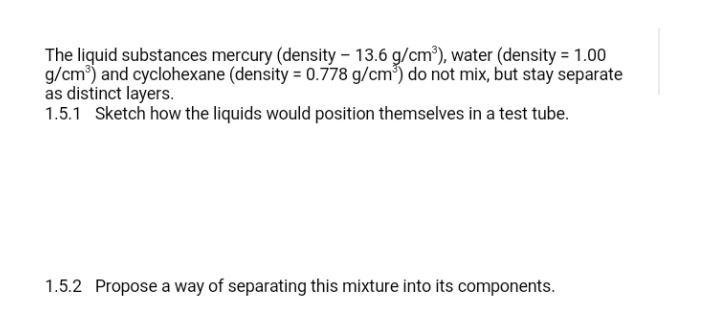The liquid substances mercury (density – 13.6 g/cm³), water (density = 1.00 g/cm) and cyclohexane (density = 0.778 g/cm³) do not mix, but stay separate as distinct layers. 1.5.1 Sketch how the liquids would position themselves in a test tube. 1.5.2 Propose a way of separating this mixture into its components.
The liquid substances mercury (density – 13.6 g/cm³), water (density = 1.00 g/cm) and cyclohexane (density = 0.778 g/cm³) do not mix, but stay separate as distinct layers. 1.5.1 Sketch how the liquids would position themselves in a test tube. 1.5.2 Propose a way of separating this mixture into its components.
Introduction to General, Organic and Biochemistry
11th Edition
ISBN:9781285869759
Author:Frederick A. Bettelheim, William H. Brown, Mary K. Campbell, Shawn O. Farrell, Omar Torres
Publisher:Frederick A. Bettelheim, William H. Brown, Mary K. Campbell, Shawn O. Farrell, Omar Torres
Chapter1: Matter, Energy, And Measurement
Section: Chapter Questions
Problem 1.81P
Related questions
Question

Transcribed Image Text:The liquid substances mercury (density – 13.6 g/cm³), water (density = 1.00
g/cm) and cyclohexane (density = 0.778 g/cm³) do not mix, but stay separate
as distinct layers.
1.5.1 Sketch how the liquids would position themselves in a test tube.
1.5.2 Propose a way of separating this mixture into its components.
Expert Solution
This question has been solved!
Explore an expertly crafted, step-by-step solution for a thorough understanding of key concepts.
This is a popular solution!
Trending now
This is a popular solution!
Step by step
Solved in 2 steps with 1 images

Recommended textbooks for you

Introduction to General, Organic and Biochemistry
Chemistry
ISBN:
9781285869759
Author:
Frederick A. Bettelheim, William H. Brown, Mary K. Campbell, Shawn O. Farrell, Omar Torres
Publisher:
Cengage Learning

Introduction to General, Organic and Biochemistry
Chemistry
ISBN:
9781285869759
Author:
Frederick A. Bettelheim, William H. Brown, Mary K. Campbell, Shawn O. Farrell, Omar Torres
Publisher:
Cengage Learning